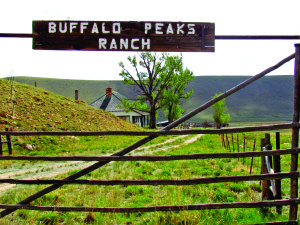by George Sibley
Badmouthing Denver and the Front Range metropolis that it has seeded is a pretty common sport in the nonmetropolitan parts of Colorado. But, we probably ought to all be asking ourselves if this isn’t a little disingenuous, and try to clarify our real water relationship with Denver.
The water planning process the state is engaged in at this point is a case in point. Colorado’s eight natural river basins and the “Metro Sink” (where no natural streams originate and quite a lot of water disappears) are engaged in planning for their water futures with a mid-century horizon. I suspect that the volunteer planners in all of those roundtables are learning about what the Gunnison Basin planners are learning. That is, that there is very little, if any, “new water” to develop, and any water for future population-driven development is probably going to have to come in some way from existing uses, most likely agriculture.
Compared to the amount of water that agricultural users control, the amount that may be needed – outside of the metropolitan area – is relatively small; so, not really a problem. The anticipated mid-century municipal, domestic and industrial demand (where water is measured in gallons) here in the Gunnison River Basin can be mostly met from retiring ranchers and farmers (who measure water in 326,000-gallon acre-feet), cashing in their land and water for a retirement fund.
But the fact is, the entire state of Colorado is engaging in water planning because the Front Range metropolis has a problem. An estimated 80 percent of the growth that might come to the state by mid-century – three to five million new residents – will most probably settle in that expanding metropolis, and they need more water from somewhere to handle that growth. The Front Range has a problem, and needs for those of us in the rest of the state to see this as our problem too, hence, a statewide water plan.
The question they probably don’t want us to ask is, “Why should we, and is Denver necessary to us to the extent that its big problems are ours too?”
That’s not a new question. Back in 1993, just before starting Colorado Central, our founder Ed Quillen spent a lot of time and energy researching it for High Country News under the working title: “Is Denver Necessary?”
Ed’s answer appeared in HCN under an even more aggressive title: “Now that Denver has abdicated … Who will coordinate and inspire the West?” (May 3, 1993) The essay presented a complex argument that essentially portrayed Denver’s evolution on what might be called the 19th-century “Chicago model,” whereby Denver tried to organize Colorado the way that Chicago had organized the Midwest to feed its resources to Chicago (at Chicago prices) and buy back what it needed through Chicago (also at Chicago prices). He traced the way the Denver & Rio Grande railroad bound the rest of the state into the Front Range on that “Chicago plan.”
Much of Ed’s argument is peripheral to my point here, except for his conclusion that Denver was not so effective at maintaining that “city-state” model as Chicago has been. This may have stemmed more from transportation problems rather than alleged “water grabs.” As the automobile and truck began to replace the little narrow-gauge trains that connected mountain Colorado to Denver, the West Slope “provinces” grew increasingly irate at how little money seemed to be available for passable mountain roads – a challenge Chicago never faced. Delays in getting a good year-round highway over Monarch Pass led Gunnison News-Champion publisher Henry Lake to fulminate the ultimate Colorado heresy in 1933 that he would “rather see the Upper Colorado River and its tributaries flow to California for beneficial use than be diverted to an area whose representatives would crush our future” through hogging the highway funds. He was not alone in this; the Walker family in Grand Junction, publishers of the Sentinel, used the highway issue in the 1950s to organize “Club 20,” unifying the West Slope counties into a lobbying force.
But trying to look at the situation realistically, there may be a kind of inevitability to this urban-rural dichotomy – going back thousands of years. Beyond a certain population density on the land, there is no more room for more farmers. Urbanization becomes essential, and every urban center must become a “city-state,” using its concentration of wealth and economy of scale to capture what it needs from the surrounding area – primarily raw resources (including water) and markets for what its people produce from those resources. And the region so captured gradually becomes a provincial hinterland, giving and receiving everything, ultimately including its culture, to and from the great and growing city.
When I find myself asking why the metropolitan water problem should also be my problem in the Gunnison Basin, I remember (and I’m mentioning this for the second month in a row here) the prairie blizzard of 2006 that immobilized Denver without dropping a flake over here in the Upper Gunnison – but within a few days, our supermarket meat and produce bins were empty, without the Safeway and King Soopers trucks rolling out of the city. Shut down the highways we now have for a month, shut off the natural gas pipelines, blow up a couple three critical nodes on the electric grid and a handful of microwave towers, and so on, and most of us would have to evacuate Central Colorado (hiking out, since there’d be no gasoline), leaving behind just the other off-grid folks.
So that’s the way it is today – but is there any decree saying this is the way it has to be, or ought to be? No – and in fact, there is an invitation on the table right now to contemplate alternatives: Governor Hickenlooper’s water planning process.
The Front Range precipitated this as a statewide process because they have a problem larger than their “basin”: where to find a few hundred thousand acre-feet of water by mid-century. No other Colorado river basin has a problem on that level. But given that precipitating fact, a slightly paranoid Denverite might suspect something almost diabolical in Governor Hickenlooper’s mandate that the state water planning process should begin with the creation of water plans for every natural river basin. Is there any serious likelihood that any basin outside the metropolitan area is going to discover – Whoa! Lookee here! We’ve got a couple hundred thousand acre-feet we aren’t using, and probably won’t ever need. The Front Range can come and get it!
Ain’t gonna happen in the Gunnison Basin. But as a member of the Gunnison Basin Plan team (speaking only for myself here), I have to ask myself how honest we are being about the future if we ignore the Denver-centric nature of our own lives in our water planning. It seems to me we have two possible planning scenarios. The obvious scenario – to acknowledge that our future is going to continue to be tied up with Denver’s future, and do what we can to help solve this “city-state” problem while still retaining options for our basin. If Denver and its burbs are the economic and cultural center of our lives (we get the Broncos without having to live there too), then their problem is our problem.
But our governor almost seems to be inviting us to consider another scenario – that we use the water resources we have to develop a different “post-urban” culture, or maybe several variations on that: basin-centric cultures capable of watering and feeding themselves (see last month’s Colorado Central issue), and providing their own energy resources from sun and water, and entertaining themselves culturally – but still trading vacations (maybe of a slightly different sort) to visitors for the currency to import coffee and other necessities that we can’t grow here.
We have been told to plan not for next year or five years, but for a third of a century, a generation beyond ourselves. Dare we get a little creative in that? Imagine a different world in which we would try to finally grow up to fit the land rather than just subdividing it into more real estate? What kind of a world do we want for our kids; are we okay with leaving them a world where they will be provincials in an increasingly remote and vulnerable hinterland of the great city, or do we want to give them the challenge of fully realizing a more locally sufficient society we might prefer to live in ourselves?
In that second scenario, so hard to really imagine except “as through a glass darkly,” our water resources would be ours first – just like this planning process suggests. But if we are going to pretend that our water resources are all ours when we are still fully dependent on the Front Range for everything we need to live here (except water), then we’re basically just freeloading hypocrites in the city-state, aren’t we?
Our governor was educated as a scientist, which suggests that he probably understands evolution and its need for options, diversity and the opportunity for grand mistakes. On the other hand, this grassroots planning invitation might just have been a political error, correctable in some kind of a political black box that will put eight plans with no extra water at one end and emerge with a single homogenized plan at the other end with half a million acre-feet of additional water for the metropolis. But wouldn’t it be kind of a waste for us provincials to not take seriously this apparent invitation to at least imagine and plan toward a network of more sustainable and homegrown hydro-societies?
George Sibley writes from the Upper Gunnison, where his working landscape these days has him up to his chin in water issues.



